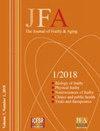与虚弱程度无关的虚弱艾滋病毒感染者的显著心理社会影响
IF 3.3
Q2 GERIATRICS & GERONTOLOGY
引用次数: 0
摘要
艾滋病毒感染者使用抗逆转录病毒疗法(ART)导致死亡率显著下降,寿命延长。然而,高发和早发的衰老相关疾病,如虚弱,对这一人群构成了新的威胁。目的:我们旨在通过比较虚弱的PLWH和匹配的未感染对照之间由心理社会、功能和身体缺陷组成的健康领域来表征虚弱;确定相关风险因素及其对负面健康结果的影响,包括死亡率风险评分、生活质量、医疗保健利用、功能残疾和病毒抑制的PLWH的跌倒史。某高等教育机构传染病门诊的横断面研究年龄在bb0 ~ 25岁,接受抗逆转录病毒治疗bb1 ~ 12个月,未怀孕且无急性疾病的个体;多民族、亚洲人的虚弱指标包括虚弱表型(FP)、虚弱量表(FS)和虚弱指数(FI)。FI健康缺陷被分类为健康领域(社会心理、功能和身体),并被用作表征虚弱的标准比较指标。将虚弱PLWH的健康域与虚弱匹配的未感染对照进行比较。应用回归分析探讨相关的危险因素和健康相关的虚弱结局。我们招募了336名PLWH。CD4+计数561(397 ~ 738)个/µl,以男性(83%)和中国人(71%)居多。PLWH中虚弱患病率为7% (FP);16% (FS)和22% (FI)。心理社会、功能和身体领域的比例在不同虚弱仪器测量的虚弱PLWH中分布相似。当与匹配的对照组相比,心理社会优势在PLWH中是显著的,但在功能和身体领域没有。确定的脆弱危险因素包括营养状况不良、CD4+计数较高、抑郁、代谢综合征、高敏感c反应蛋白(hsCRP)和艾滋病定义疾病(ADI)史。虚弱影响负面健康结局的风险,包括死亡风险评分增加、生活质量(QOL)差、频繁使用医疗保健和功能残疾增加(p<0.05)。本研究强调了心理社会影响在多种族、亚洲环境中治疗的PLWH中衰弱发展的重要性。本文章由计算机程序翻译,如有差异,请以英文原文为准。
Significant Psychosocial Influence in Frail People Living with HIV Independent of Frailty Instrument Used
Antiretroviral therapy (ART) usage among people living with HIV (PLWH) has led to significant mortality declines and increasing lifespan. However, high incidence and early onset of aging-related conditions such as frailty, pose as a new threat to this population. OBJECTIVES: We aimed to characterize frailty by comparing health domains consisting of psychosocial, functional and physical deficits between frail PLWH and matched uninfected controls; identify associated risk factors and the impact on negative health outcomes including mortality risk score, quality of life, healthcare utilization, functional disability and history of falls among virally suppressed PLWH. Cross-sectional study Infectious disease clinic in a tertiary institution Individuals aged >25 years, on ART > 12 months, not pregnant and without acute illness; multi-ethnic, Asian Frailty instruments included Frailty phenotype (FP), FRAIL scale (FS) and Frailty index (FI). FI health deficits were categorized into health domains (psychosocial, functional and physical) and used as standard comparator to characterize frailty. Health domains of frail PLWH were compared with frail matched, uninfected controls. Regression analyses were applied to explore associated risk factors and health-related frailty outcomes. We recruited 336 PLWH. Majority were male (83%), Chinese (71%) with CD4+ count 561 (397–738) cells/µl. Frailty prevalence among PLWH were 7% (FP); 16% (FS) and 22% (FI). Proportions of psychosocial, functional, and physical domains were similarly distributed among frail PLWH measured by different frailty instruments. When compared with matched controls, psychosocial dominance was significant among the PLWH, but not in functional and physical domains. Identified frailty risk factors included poor nutritional status, higher CD4+ count nadir, depression, metabolic syndrome, higher highly sensitive C-reactive protein (hsCRP) and history of AIDS-defining illness (ADI). Frailty influenced the risk for negative health outcomes including increased mortality risk scores, poor quality of life (QOL), frequent healthcare utilization and increased functional disability (p<0.05). This study highlighted the importance of psychosocial influence in the development of frailty among treated PLWH in a multiethnic, Asian setting.
求助全文
通过发布文献求助,成功后即可免费获取论文全文。
去求助
来源期刊

Journal of Frailty & Aging
GERIATRICS & GERONTOLOGY-
CiteScore
5.90
自引率
7.70%
发文量
54
期刊介绍:
The Journal of Frailty & Aging is a peer-reviewed international journal aimed at presenting articles that are related to research in the area of aging and age-related (sub)clinical conditions. In particular, the journal publishes high-quality papers describing and discussing social, biological, and clinical features underlying the onset and development of frailty in older persons. The Journal of Frailty & Aging is composed by five different sections: - Biology of frailty and aging In this section, the journal presents reports from preclinical studies and experiences focused at identifying, describing, and understanding the subclinical pathophysiological mechanisms at the basis of frailty and aging. - Physical frailty and age-related body composition modifications Studies exploring the physical and functional components of frailty are contained in this section. Moreover, since body composition plays a major role in determining physical frailty and, at the same time, represents the most evident feature of the aging process, special attention is given to studies focused on sarcopenia and obesity at older age. - Neurosciences of frailty and aging The section presents results from studies exploring the cognitive and neurological aspects of frailty and age-related conditions. In particular, papers on neurodegenerative conditions of advanced age are welcomed. - Frailty and aging in clinical practice and public health This journal’s section is devoted at presenting studies on clinical issues of frailty and age-related conditions. This multidisciplinary section particularly welcomes reports from clinicians coming from different backgrounds and specialties dealing with the heterogeneous clinical manifestations of advanced age. Moreover, this part of the journal also contains reports on frailty- and age-related social and public health issues. - Clinical trials and therapeutics This final section contains all the manuscripts presenting data on (pharmacological and non-pharmacological) interventions aimed at preventing, delaying, or treating frailty and age-related conditions.The Journal of Frailty & Aging is a quarterly publication of original papers, review articles, case reports, controversies, letters to the Editor, and book reviews. Manuscripts will be evaluated by the editorial staff and, if suitable, by expert reviewers assigned by the editors. The journal particularly welcomes papers by researchers from different backgrounds and specialities who may want to share their views and experiences on the common themes of frailty and aging.The abstracting and indexing of the Journal of Frailty & Aging is covered by MEDLINE (approval by the National Library of Medicine in February 2016).
 求助内容:
求助内容: 应助结果提醒方式:
应助结果提醒方式:


